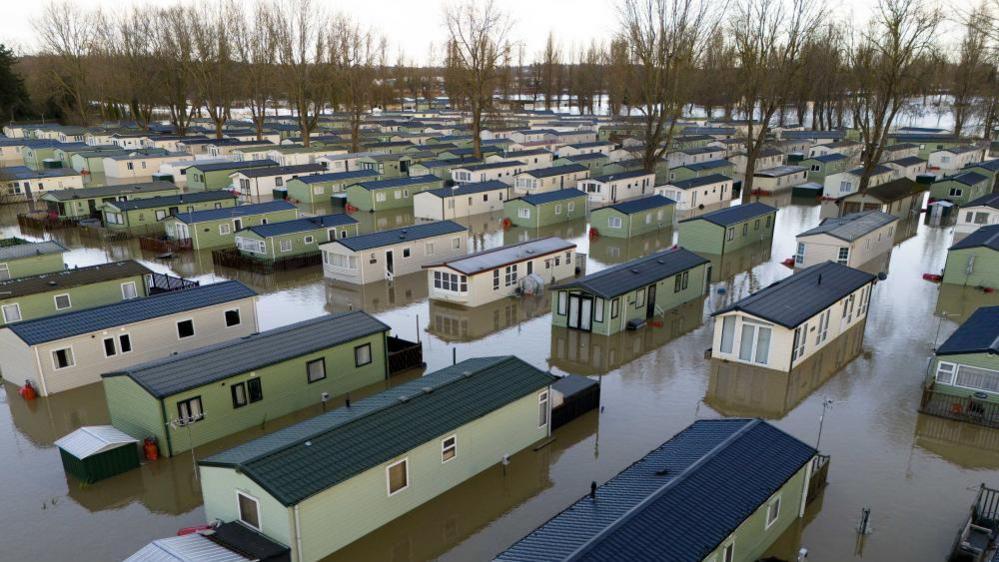One in four properties at flood risk by 2050 - report

- Published
Around eight million properties in England - or one in four - could be at risk of flooding by 2050 as the danger increases due to climate change, the Environment Agency (EA) has said.
In its first assessment of how a warming world could affect flooding, the EA warned of increasing threats from heavier rainfall and rising sea levels.
The number of at-risk properties could be even higher if more houses are built on floodplains, but could be lower if flood defences are improved.
Currently, 6.3 million properties are considered at risk from flooding, new figures show, which is higher than previously thought.
Sea level rise threatens 200,000 properties
- Published15 June 2022
"The frequency and severity of the kind of flood events that we've been experiencing are likely to become more and more challenging," Julie Foley, director of flood risk strategy at the Environment Agency, said.
The EA considers flooding from three main sources: rivers, the sea and surface water - where heavy rainfall overwhelms drainage systems.
It defines properties as being "at risk" when the yearly chance of flooding is greater than one-in-1,000.
Currently, the EA says that 4.6 million homes and businesses are at risk of surface flooding, with London the most affected region.
This is a 43% rise on its previous estimate, but this is almost entirely due to improved datasets and computer modelling techniques, rather than a real-world increase in flood risk.

However, the EA says that climate change could raise the number of properties at risk of surface flooding to around 6.1 million by the middle of the century.
It is well-documented that a warming world generally increases the intensity of heavy rainfall.
Between October 2023 and March 2024, for example, the amount of rainfall on the stormiest days in the UK increased by an estimated 20% on average due to climate change.
The report also highlights a rising risk of flooding from rivers and the sea - from 2.4 million properties today to around 3.1 million by mid-century.
The East Midlands, Yorkshire and The Humber, and south-east England are particularly at risk.
This type of flooding - from rivers bursting their banks or storm surges bringing seawater onto shore - can be particularly damaging as it often brings deeper floodwaters.
Wetter winters increase the chances of river flooding, while sea-level rise makes coastal flooding more likely.
Global sea levels are rising mainly due to a combination of melting glaciers and ice sheets, and the fact that warmer water takes up more space. They are expected to continue rising for centuries to come.
Average sea levels around the UK have already risen by nearly 20cm since 1900, with most of that occurring since 1990.
This also has knock-on effects for coastal erosion - the displacement of land along coastlines due to the action of waves.
The UK already has some of the fastest eroding coastlines in Europe.
But climate change could increase the number of properties at risk of effectively being lost into the sea to nearly 20,000 by 2100, even if adequate shoreline management plans are put in place, the EA says.
That would be up from 3,500 between now and mid-century.
Preparations for flooding
This report only considers how climate change affects future flood risk.
There are many other factors, from building on floodplains to improvements to flood defences, that could shape the impacts of flooding in the future.
Partly thanks to the Thames Barrier flood defence, for example, London is currently considered less at risk of flooding from rivers and the sea than some other regions.
But there have been repeated warnings that the UK is poorly prepared for the impacts of a changing climate.
Earlier this year, a cross-party committee of MPs warned that the government had not maintained enough of its existing flood defences or built enough new ones. A lack of funding has been a key issue.
In response to today's report, Floods Minister Emma Hardy acknowledged that "too many communities are exposed to the dangers of flooding".
"That is why we have committed £2.4 billion over the next two years to maintain, repair and build flood defences to protect communities across the country," she said.
Additional reporting by Jonah Fisher and Miho Tanaka; map by Erwan Rivault

Sign up for our Future Earth newsletter to get exclusive insight on the latest climate and environment news from the BBC's Climate Editor Justin Rowlatt, delivered to your inbox every week. Outside the UK? Sign up to our international newsletter here.